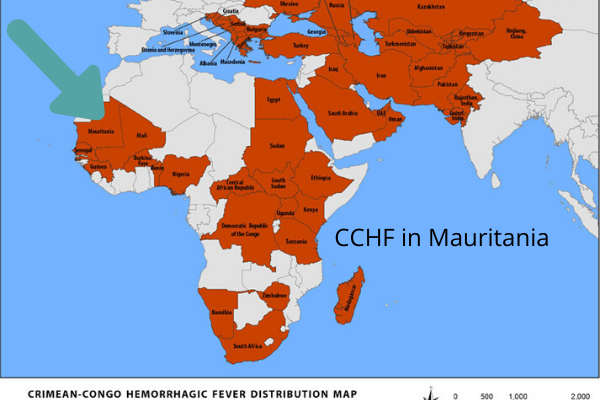 According to WHO, on 4 February 2022, a case of Crimean-Congo hemorrhagic fever (CCHF) was confirmed by polymerase chain reaction (PCR) at the Institut National de Recherche en Santé Publique in Nouakchott, Mauritania. The patient is a 52-year-old male farmer living in the department (moughataa) of Koubeni in the region (wilaya) of Hodh Elgharbi.He presented with epistaxis and hematemesis for which he consulted five health facilities in Kubeni and Nouakchott between 27 January and 4 February 2022.
According to WHO, on 4 February 2022, a case of Crimean-Congo hemorrhagic fever (CCHF) was confirmed by polymerase chain reaction (PCR) at the Institut National de Recherche en Santé Publique in Nouakchott, Mauritania. The patient is a 52-year-old male farmer living in the department (moughataa) of Koubeni in the region (wilaya) of Hodh Elgharbi.He presented with epistaxis and hematemesis for which he consulted five health facilities in Kubeni and Nouakchott between 27 January and 4 February 2022.
Crimean-Congo hemorrhagic fever is a widespread disease caused by a tick-borne virus (Nairovirus) of the Bunyaviridae family. The CCHF virus causes severe viral hemorrhagic fever outbreaks, with a case fatality rate of 10–40%.
Animals become infected by the bite of infected ticks and the virus remains in their bloodstream for about one week after infection, allowing the tick-animal-tick cycle to continue when another tick bites. Although a number of tick genera are capable of becoming infected with CCHF virus, ticks of the genus Hyalomma are the principal vector.
The CCHF virus is transmitted to people either by tick bites or through contact with infected animal blood or tissues during and immediately after slaughter. The majority of cases have occurred in people involved in the livestock industry, such as agricultural workers, slaughterhouse workers and veterinarians. Human-to-human transmission is possible.
Source : http://outbreaknewstoday.com/mauritania-crimean-congo-hemorrhagic-fever-update-66698/
